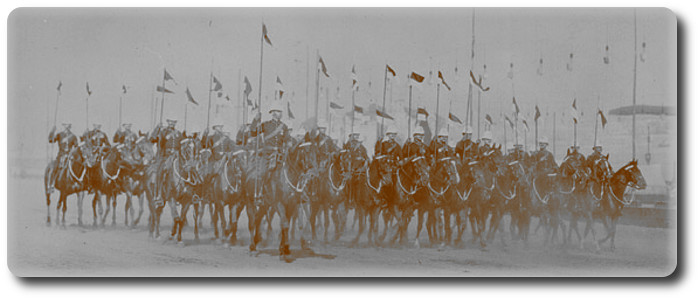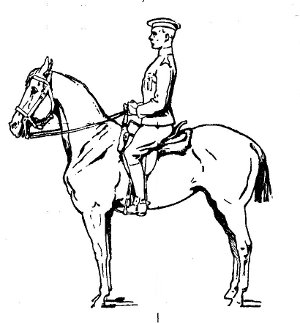Topic: Canadian Militia

Although not quite matching the period of the following article, this image shows the Royal Canadian Dragoons Musical ride at the Canadian National Exhibition ca. 1920 (NLA)
The Cavalry School Sports
Military Men and Matters
The Montreal Gazette, 5 March 1892
 The Cavalry school sports last week were a complete success in every respect, and it is really surprising that they were not patronized. On Montreal it would have been hard to find room for the spectators , while here [Quebec], although the reserved seats sold for only 50 cents, there was a very slim attendance, and it is doubtful whether the receipts covered the expenditure. It was a spectacle such as cannot be witnessed elsewhere in Canada. To those who have never witnessed cavalry sports a brief description of some of the principal events may prove of interest. Plaiting the maypole is familiar enough to those who have attended the skating carnivals in Montreal, and by substituting for skaters soldiers in gay hussar uniforms and mounted on spirited horses, one can form a fair idea of the brilliance of the spectacle. After plaiting and unplaiting at the walk the band struck up "The Keel Row" and the movement was again gone through at the trot and a third time at the gallop to the tune of "Bonnie Dundee." It was remarkable how the horses kept time to the music. The gallop was not altogether a success for some of the horses, excited by the lights, the music and the strange surroundings, became unmanageable towards the close and it had to be cut short.
The Cavalry school sports last week were a complete success in every respect, and it is really surprising that they were not patronized. On Montreal it would have been hard to find room for the spectators , while here [Quebec], although the reserved seats sold for only 50 cents, there was a very slim attendance, and it is doubtful whether the receipts covered the expenditure. It was a spectacle such as cannot be witnessed elsewhere in Canada. To those who have never witnessed cavalry sports a brief description of some of the principal events may prove of interest. Plaiting the maypole is familiar enough to those who have attended the skating carnivals in Montreal, and by substituting for skaters soldiers in gay hussar uniforms and mounted on spirited horses, one can form a fair idea of the brilliance of the spectacle. After plaiting and unplaiting at the walk the band struck up "The Keel Row" and the movement was again gone through at the trot and a third time at the gallop to the tune of "Bonnie Dundee." It was remarkable how the horses kept time to the music. The gallop was not altogether a success for some of the horses, excited by the lights, the music and the strange surroundings, became unmanageable towards the close and it had to be cut short.
The wrestling on horseback showed how much it takes to unseat a good rider. Half a dozen men from the cavalry were matched against an equal number from the mounted division of the Battery. They discarded headdress and tunics and rode into the ring bareheaded and wearing tight-fitted blouses. No saddles were used. The squads were drawn up at opposite ends of the hall and when word was given they rode slowly at each other. When the lines had almost met one of the troopers (an old Montreal boy) dashed at the man opposite him, passed his arm round his waist and threw him to the ground. This left him free to go to the assistance of one of his comrades who was hard beset by a stalwart artilleryman, and between the two they hoisted him out of his seat and threw him. Then a trooper bit the dust, and immediately afterwards he was followed by a batteryman. This left five of the cavalry to three of the artillery.
To the right hand of the Lieutenant Governor's box an artilleryman was making a gallant fight against two cavalrymen. He backed his horse, pushed it forward and twisted it from side to side, now breaking away from his assailants and now tackling one or the other, as he saw an opportunity, but before he could dismount either of them the other was upon him. He fought his way across the hall and part way back, when a cheer was heard from the upper part of the hall, and a batteryman was seen to go over his horse;'s shoulder, dragging a trooper with him. This left four to two, and although there was no chance now of his being relieved of one of his opponents the batteryman fought on, surrounded now by three troopers. Finally one of them seized him by the collar, and a second coming up on his other side caught him by the leg, and between the two he was thrown to the ground. His horse then jumped over him and tore away to the other end of the hall, where it was captured. The last remaining artilleryman, seeing himself opposed by four troopers, lost heart and was easily thrown without doing any further damage.
The sword combats on horseback were most exciting. The men wore wooden masks, something like a diver's helmet, and thick leather jackets and were armed with single sticks. The vanquished men retired and the victors were matched against each other until in a final tie there was a private and a sergeant. The private was mounted on a very nervous horse, which could not be brought up to face his opponent, and up to the present he had only won by his skill in the handling of his weapon. His last opponent took advantage of the nervousness of his horse, and by making sudden starts and feint's the trooper's horse backed him up against a fence. Here a lively scrimmage occurred and the sergeant scored the first point, but the private scored the next two and won amid the wildest cheering.
In the combats of sword versus bayonet the superiority of the latter weapon was invariably demonstrated. The weapons used were blunt swords and spring bayonets like the daggers used upon the stage, and have a button on the end of them. When they strike a man the bayonet, instead of penetrating, run back up the rifle. The first combat was between two artillerymen, both dismounted. The swordsman made one point by closing with hos opponent as soon as he parried the bayonet thrust and, seizing the bayonet with his left hand, brought down his sword on the other's head. In attempting to repeat this performance the swordsman came to grief, for his opponent dropped the bayonet and relied altogether on his wrestling abilities. The swordsman endeavored to stab his opponent in the shoulder and back, but was so tightly clinched that he could not use his weapon to advantage. The two men fell and rolled over and over in the scuffle, each trying to disarm the other. Finally the swordsman let his weapon go and, throwing of his opponent, snatched up the bayonet and had it at the other's breast before he could recover. The point was, however, awarded to the bayonet, which won. Then the two men exchanged weapons, but with the same result. Bayonet won again.
Then the bayonet was pitted against a trooper on horseback armed with a sword. It is well known that in such a combat the man on foot has a great advantage, but how great that advantage is can only be appreciated by a test like this. The trooper charged down on the dismounted man, but as soon as the horse cam within reach of the bayonet he recoiled, and it was all the trooper could do to pull him aside in time to avoid a thrust. Several time he tried to gallop past men near enough to strike the foot soldier, but the latter always jumped right in front of the horse or, if not in time to do that, he jumped back out of reach of the sword. Finally they came to close quarters and after several cuts and thrusts the bayonet scored. In the second bout the trooper parried a thrust and brought down his sword with a will upon the artilleryman's helmet, but in the next round the latter scored again ans was declared the winner.
The musical ride would be hard to describe. The troopers were armed with steel shod lances with fluttering pennants and went through all kinds of movements that seemed designed as much to test the horsemanship of the men as to please the eye of the spectator. Some of the movements were exceedingly intricate and with horses as spirited as those of the Cavalry school any but thorough horsemen would inevitably have lost their heads. It is much to the credit of the men, therefore, that not a single mistake was made. After an exhibition of lance drill the troops formed up at the opposite end of the hall and with a wild yell charged down to within a few feet from the Governor's box, when they halted as suddenly as if the horses and men had been turned to stone. It gave one a good idea of what he would feel if he had to face a cavalry charge. Many of those in the front seats started up in alarm and would have fled had there been time, but the whole thing was over like a flash.
His Honor, the Lieutenant Governor, accompanied by a large party, attended every night and on each occasion everyone in the hall rose and uncovered when he arrived and departed. The object of the entertainment was to raise funds for the purchase of the spring bayonets, lances, helmets, etc., without which our soldiers could not get the practical training that European soldiers got. These articles are not provided by the Government and Col. Turnbull ordered them from England at a cost of $500, guaranteeing the payment out of his own pocket. Several hundred dollars were also spent by the committee in fitting up the drill hall with platform and fences, decorating it with flags, etc., and providing prizes. If there should be any surplus it will be divided equally among the men. The training the men have gone through in preparation for these sports have done them more good than six months of ordinary drill. The attendance of Lieutenant Governor Angers and suite in a private box was much appreciated by all, and, after a most successful entertainment he graciously consented to present the prizes, which amounted to about $150, to the winners, who paraded in front of the grand stand. It is also pleasing to note that owing to the excellent arrangements and special training of both men and horses not a single accident happened during the three evenings, and a general desire has been expressed throughout the community that another representation may, at some future date, be forthcoming when our military friends may be certain to have full houses.

